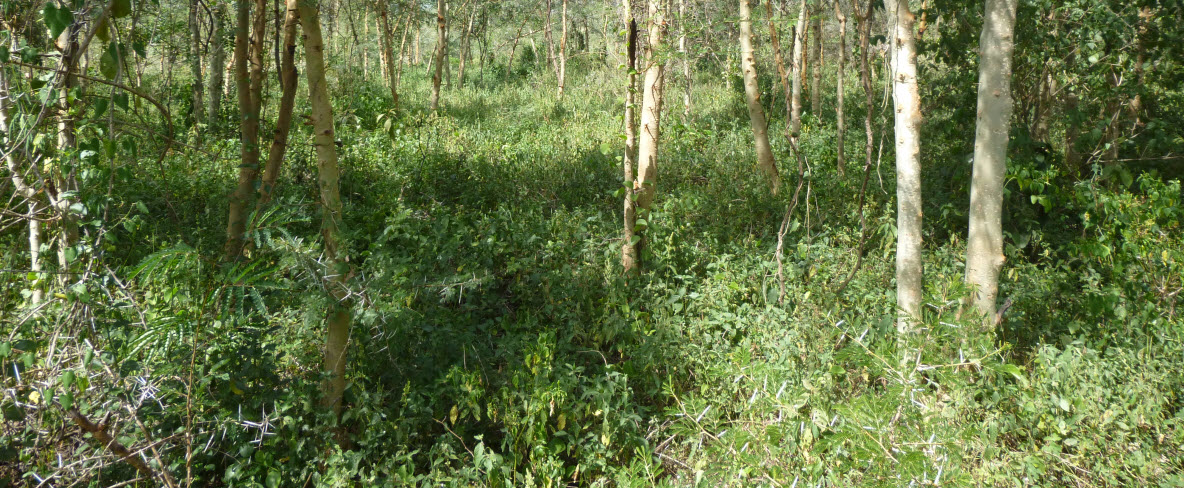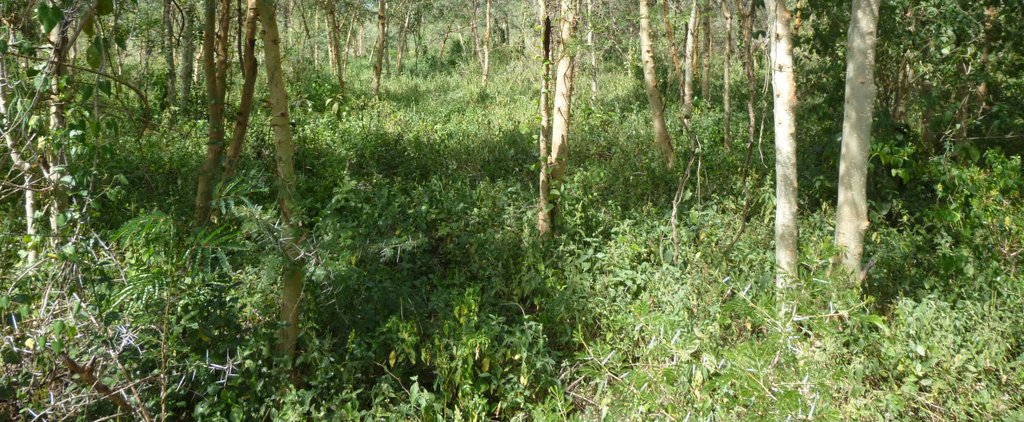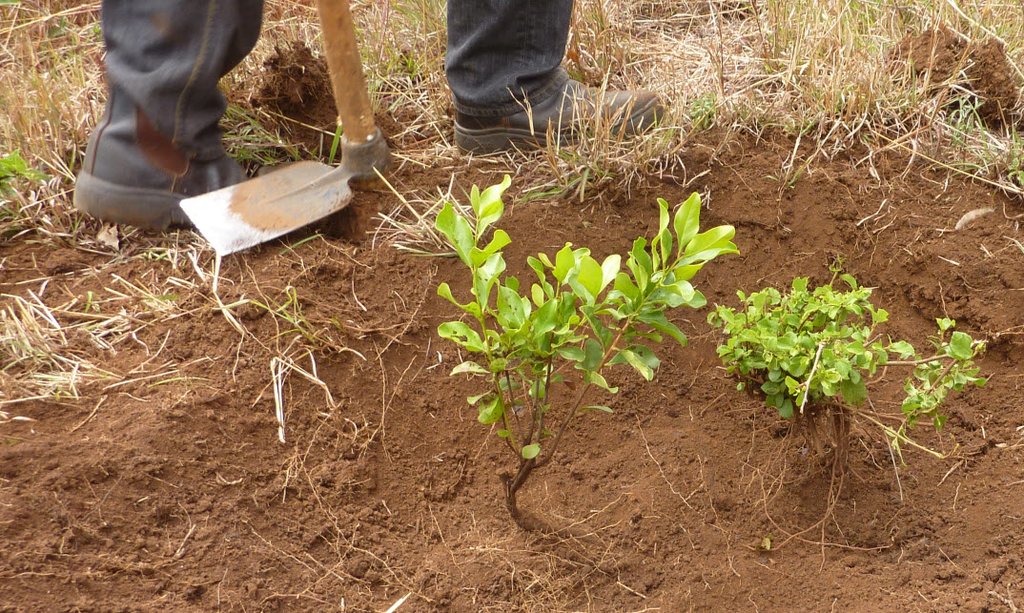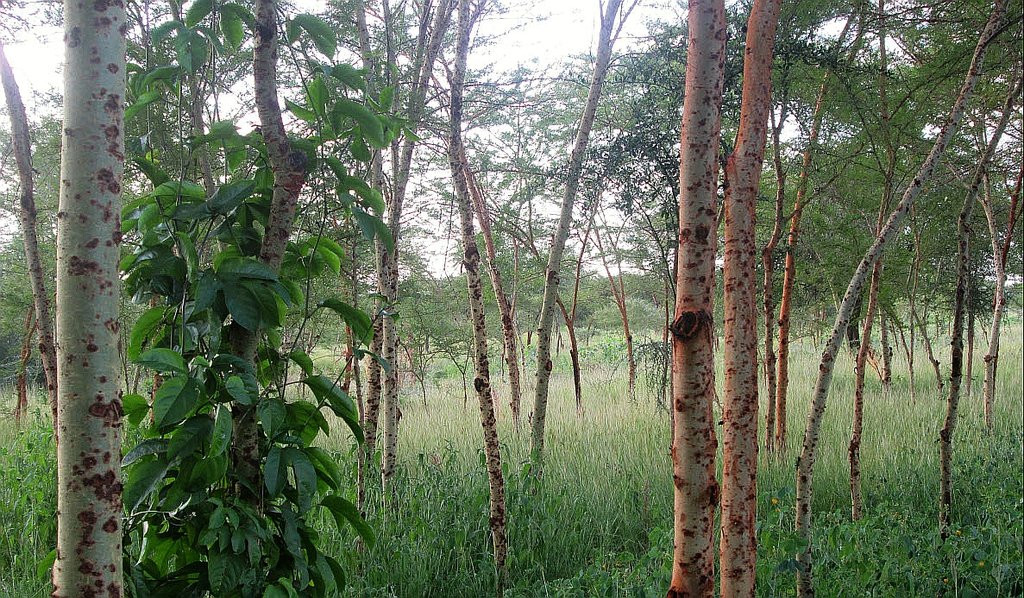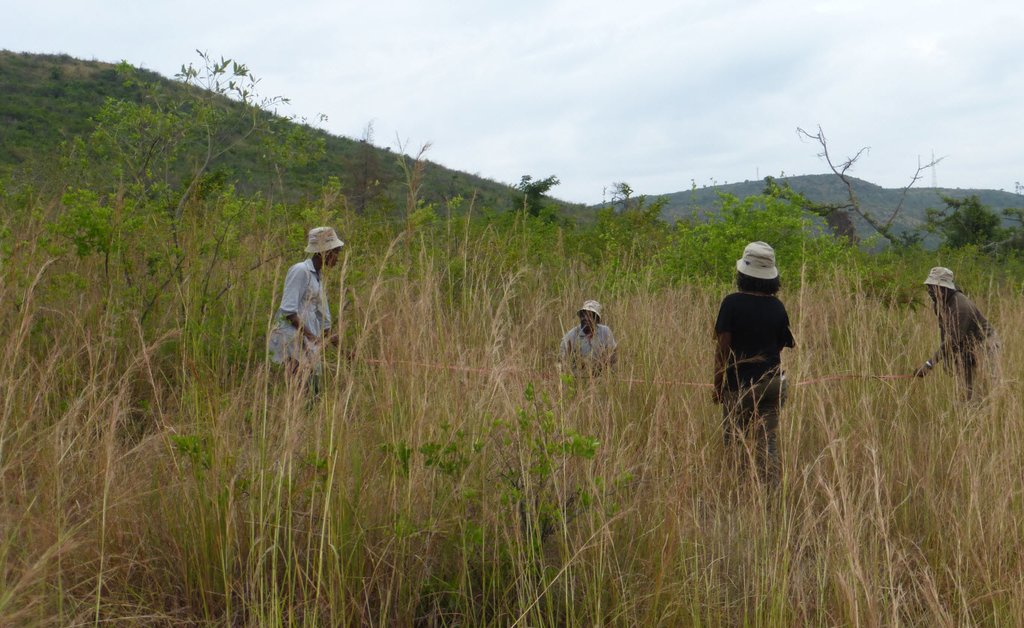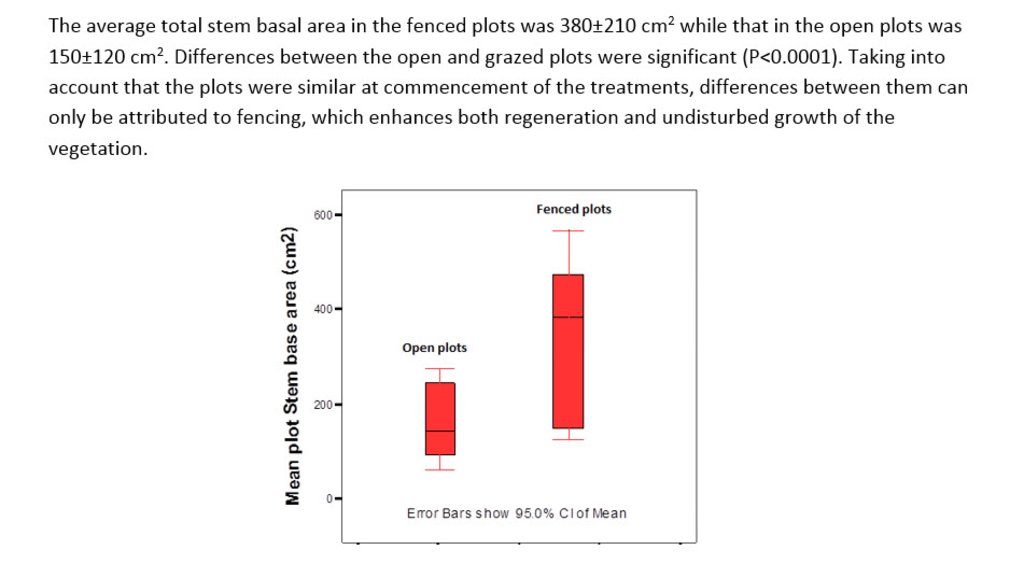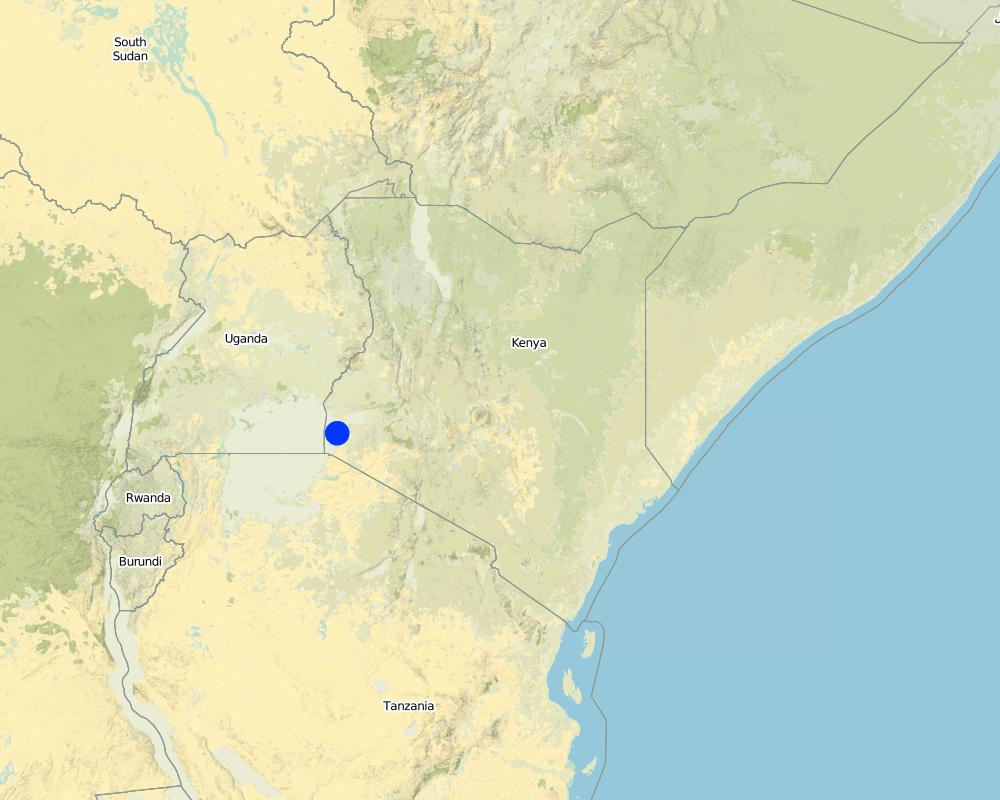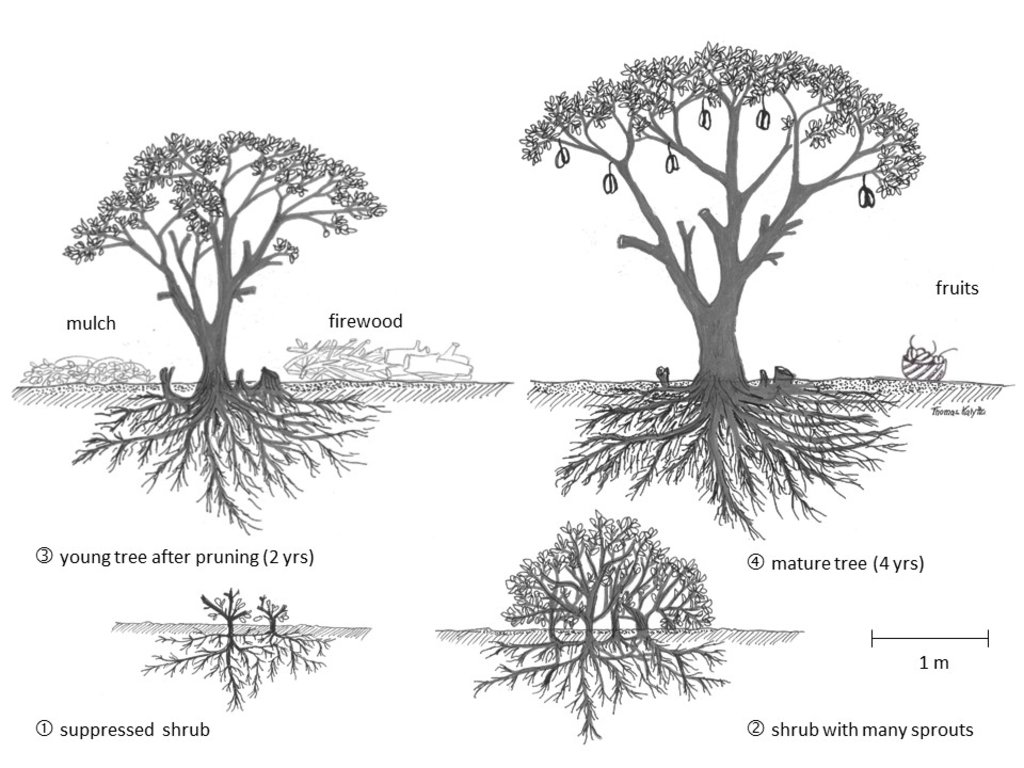Farmer Managed Natural Regeneration (FMNR) [ເຄັນຢາ]
- ການສ້າງ:
- ປັບປູງ:
- ຜູ້ສັງລວມຂໍ້ມູນ: Thomas Kalytta
- ບັນນາທິການ: Irene Ojuok
- ຜູ້ທົບທວນຄືນ: Hanspeter Liniger, Nicole Harari, Alexandra Gavilano, David Streiff, Fabian Ottiger, Mathias Gurtner
FMNR
technologies_507 - ເຄັນຢາ
ເບິ່ງພາກສ່ວນ
ຂະຫຍາຍທັງໝົດ ຍຸບທັງໝົດ1. ຂໍ້ມູນທົ່ວໄປ
1.2 ຂໍ້ມູນ ການຕິດຕໍ່ພົວພັນ ຂອງບຸກຄົນທີ່ສໍາຄັນ ແລະ ສະຖາບັນ ທີ່ມີສ່ວນຮ່ວມ ໃນການປະເມີນເອກກະສານ ເຕັກໂນໂລຢີ
ບັນດາຜູ້ຕອບແບບສອບຖາມທີ່ສໍາຄັນ ()
ຜຸ້ຊ່ຽວຊານ ດ້ານການຄຸ້ມຄອງ ທີ່ດິນແບບຍືນຍົງ:
Ojuok Irene
World Vision
ເຄັນຢາ
Kalytta Thomas
World Vision
ຜູ້ນໍາໃຊ້ທີ່ດິນ:
Sijenyi Onyiego William
Obanda Environmental project
ເຄັນຢາ
ຊື່ໂຄງການ ທີ່ອໍານວຍຄວາມສະດວກ ໃນການສ້າງເອກກະສານ/ປະເມີນ ເຕັກໂນໂລຢີ (ຖ້າກ່ຽວຂ້ອງ)
Book project: where people and their land are safer - A Compendium of Good Practices in Disaster Risk Reduction (DRR) (where people and their land are safer)ຊື່ສະຖາບັນ (ຫຼາຍສະຖາບັນ) ທີ່ອໍານວຍຄວາມສະດວກ ໃນການສ້າງເອກກະສານ / ປະເມີນ ເຕັກໂນໂລຢີ (ຖ້າກ່ຽວຂ້ອງ)
World Vision (World Vision) - ສະວິດເຊີແລນ1.3 ເງື່ອນໄຂ ກ່ຽວກັບ ການນໍາໃຊ້ຂໍ້ມູນເອກະສານ ທີ່ສ້າງຂື້ນ ໂດຍຜ່ານ ອົງການພາບລວມຂອງໂລກ ທາງດ້ານແນວທາງ ແລະ ເຕັກໂນໂລຢີ ຂອງການອານຸລັກ ທໍາມະຊາດ (WOCAT)
ຜູ້ປ້ອນຂໍ້ມູນ ແລະ ບຸກຄົນສຳຄັນ ທີ່ໃຫ້ຂໍ້ມູນ (ຫຼາຍ) ຍິນຍອມ ຕາມເງື່ອນໄຂ ໃນການນຳໃຊ້ຂໍ້ມູນ ເພື່ອສ້າງເປັນເອກກະສານຂອງ WOCAT:
ແມ່ນ
1.4 ແຈ້ງການວ່າ ດ້ວຍຄວາມຍືນຍົງຂອງ ເຕັກໂນໂລຢີ
ການນໍາໃຊ້ ເຕັກໂນໂລຢີ ດັ່ງກ່າວໄດ້ອະທິບາຍ ເຖິງບັນຫາ ກ່ຽວກັບ ການເຊື່ອມໂຊມຂອງດິນບໍ? ຖ້າບໍ່ດັ່ງນັ້ນ ມັນບໍ່ສາມາດ ຢັ້ງຢືນໄດ້ວ່າ ເປັນເຕັກໂນໂລຊີ ໃນການຄຸ້ມຄອງ ທີ່ດິນແບບຍືນຍົງ? :
ບໍ່ແມ່ນ
ຄວາມຄິດເຫັນ:
It is a very sustainable technology as it promotes the natural regeneration of highly degraded areas.
1.5 ແບບສອບຖາມທີ່ອ້າງອີງເຖີງແນວທາງ ການຄຸ້ມຄອງທີ່ດິນແບບຍືນຍົງ (ໄດ້ເຮັດເປັນເອກະສານທີ່ໃຊ້ WOCAT)
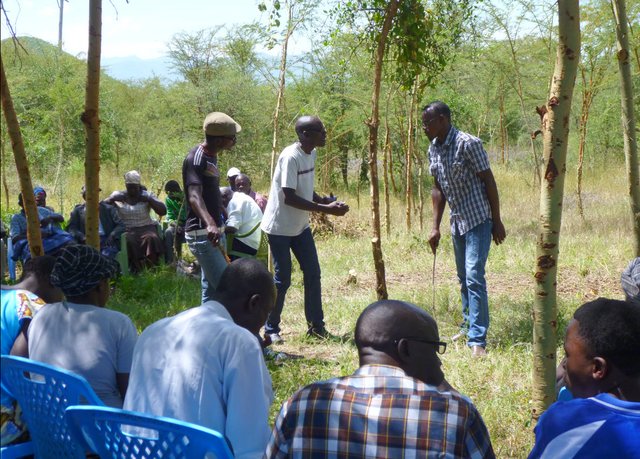
FMNR implementation approach [ເຄັນຢາ]
After consultations with local stakeholders, experts (from NEMA, ICRAF, KFS, Wildlife Kenya) and Homabay County Government representatives the FMNR approach is being introduced by World Vision through a public funded project. The aim of the approach is to promote FMNR and sustainable land and natural resource management through disseminating the …
- ຜູ້ສັງລວມຂໍ້ມູນ: Thomas Kalytta
2. ການອະທິບາຍ ເຕັກໂນໂລຢີ ຂອງການຄຸ້ມຄອງ ທີ່ດິນແບບຍືນຍົງ
2.1 ຄໍາອະທິບາຍສັ້ນຂອງ ເຕັກໂນໂລຢີ
ການກຳໜົດຄວາມໝາຍ ຂອງເຕັກໂນໂລຢີ:
Farmer Managed Natural Regeneration (FMNR) is a proven SLM Technology to restore degraded wasteland and improve depleted farmland. The farmer regu- lates and facilitates the re-growth of existing trees stumps, or self-sown seeds in the soil, and thus promotes soil fertility and through better ground cover, increases protection from runoff and erosion.
2.2 ການອະທິບາຍ ລາຍລະອຽດ ຂອງເຕັກໂນໂລຢີ
ການພັນລະນາ:
Conventional afforestation and tree planting requires considerable inputs, labour and care including suitable seedlings, transport of these, planting and regular watering - and the survival rate in arid and semi-arid climates is often very poor. On the other hand Farmer Managed Natural Regeneration (FMNR) is a cheap and effective way to restore and improve large areas of degraded and depleted soils. The technology relies on the fact that even in deforested areas, soils often still maintain some active roots systems and viable seeds of native woody plants. Selectively promoted, leaving only a few main shoots, they can grow into trees within a few years. This technology - based on indigen- ous practices - has been successfully promoted by World Vision in eight African countries including Kenya and Ethiopia, and is now also being applied in Indonesia, East Timor and Latin America. Apart from labour and a farmer’s knife, and skills, there are no major inputs required. The farmers like this agroforestry technology a it is cheap and can be easily combined with other SLM technolo- gies such as permaculture, inter-cropping, and mulching. At the same time it can be used at various scales: on small plots of less than one hectare or up to the landscape level where whole hills can be re-vegetated within a short period. And the impact can be very positive on the soil, ecology, cli- mate and health of crops, people and livestock. The farmer can use prunings as rewood, and grow fodder below the trees; tree branches and leaves can serve for mulching and the owers for bees, fruits for consumption and sale. The trees break the winds, protect the soil and (with some species) their shade protects sensitive crops (e.g. vegetables or even coffee) from the sun. The soil’s water retention capacity, structure, biology and fertility improve. All effects contribute to soil, water and climate stabilization. One limitation can be the use of tractors and other machines which, however, are hardly employed by smallholder farmers. Some practical steps for establishing an FNMR site; 1) jointly agree on a target area (be it a eld or communal wasteland) 2) check out the area carefully for existence of woody species (trees, bushes, rootstocks) 3) mark the bushes or trees that should be nurtured into bigger trees (it is recommended to consult local/scientific knowledge on the trees species and their positive benefits) 4) protect the whole area (fences, hedges) or only the chosen trees against grazing and human disturbance 5) when the plants reach a height of 1 m start with pruning, only keeping the 2-3 main shoots, using the prunings for rewood or mulching 6) watering is in most cases not required as the indigenous trees have well-enough developed roots for self- supply 7) the specific cultivation and management practice depends on the trees species selected and the desired results (intercropping with maize, shade trees for coffee, fodder trees for livestock, flower trees for bees etc.) 8) fire and livestock are the are the main threats for a new FMNR site.
2.3 ຮູບພາບຂອງເຕັກໂນໂລຢີ
ຂໍ້ສັງເກດທົ່ວໄປທີ່ກ່ຽວກັບຮູບພາບ:
The photos were taken during 2 years while introducing FMNR to the 1000 small holder farmers in Homabay County.
2.4 ວິດີໂອ ເຕັກໂນໂລຢີ
ຄວາມຄິດເຫັນ, ຄໍາອະທິບາຍຫຍໍ້:
Tony Rinaudo gives an introduction to Farmer Managed Natural Regeneration Project Model. It is something that can be implemented relatively quickly with a low budget and have a great impact. FMNR has big implications for income generation, Disaster Risk Reduction, reducing proness to famine, conflict reduction, land and forest restoration, food security, climate change adaptation and mitigation... amongst other things.
https://vimeo.com/55277450
ວັນທີ:
2012
ສະຖານທີ່:
Niger etc.
ຊື່ຂອງຜູ້ຖ່າຍວີດີໂອ:
World Vision
ຄວາມຄິດເຫັນ, ຄໍາອະທິບາຍຫຍໍ້:
(Video in German language)
It is a method with a great success: Farmer Managed Natural Regeneration (FMNR). World Vision employee Tony Rinaudo paves the way to grow trees, where hardly anything is produced. Meanwhile, the people in the Humbo region of Ethiopia are earning money from global emissions trade through greening their country. The World Bank is promoting the project and the local people can now provide for a better future. But in the beginning it was not easy for Tony Rinaudo and his colleagues to convince the farmers to protect the forest!
Es ist eine Methode, die durchschlagenden Erfolg hat: Farmer Managed Natural Regeneration (FMNR).
World Vision Mitarbeiter Tony Rinaudo lässt Bäume aufwachsen, wo das Land kaum noch etwas hervorbringt. Mittlerweile verdienen die Menschen in der Region Humbo in Äthiopien durch die Wiederbegrünung Geld im weltweiten Emissionshandel. Die Weltbank fördert das Projekt und die Menschen vor Ort können nun selbst für eine bessere Zukunft sorgen. Doch am Anfang war es nicht leicht für Tony Rinaudo und seine Mitstreiter, die Bauern davon zu überzeugen den Wald zu schützen!
https://vimeo.com/189822143
ວັນທີ:
26/06/2012
ສະຖານທີ່:
Humbo, Ethiopia
ຊື່ຂອງຜູ້ຖ່າຍວີດີໂອ:
World Vision
ຄວາມຄິດເຫັນ, ຄໍາອະທິບາຍຫຍໍ້:
Original (edited) footage of a 1990 visit to Niger where Farmer Managed Natural Regeneration (FMNR) was being practiced. Features an interview with Tony Rinaudo and one of the early adopters. Tony was a SIM missionary who pioneered and developed this management practice. It is now being practiced on millions of hectares in Niger and other countries in the Sahel. Part 1: https://vimeo.com/189821376
Part 2: https://vimeo.com/189821948
ວັນທີ:
1990
ສະຖານທີ່:
Niger
ຊື່ຂອງຜູ້ຖ່າຍວີດີໂອ:
Barry Rands
2.5 ປະເທດ / ເຂດ / ສະຖານທີ່ບ່ອນທີ່ ເຕັກໂນໂລຢີ ໄດ້ຮັບການນໍາໃຊ້ ແລະ ທີ່ຖືກປົກຄຸມດ້ວຍການປະເມີນຜົນ
ປະເທດ:
ເຄັນຢາ
ພາກພື້ນ / ລັດ / ແຂວງ:
Homa Bay Country
ຂໍ້ມູນເພີ່ມເຕີມຂອງສະຖານທີ່:
Suba and Mbita Sub-Counties
ໃຫ້ລະບຸ ການແຜ່ຂະຫຍາຍ ເຕັກໂນໂລຢີ:
- ແຜ່ຂະຫຍາຍຢ່າງໄວວາໃນພື້ນທີ່
ຖ້າຫາກບໍ່ຮູ້ເນື້ອທີ່ທີ່ແນ່ນອນ, ໃຫ້ລະບຸ ເນື້ອທີ່ໂດຍປະມານ ທີ່ໃກ້ຄຽງ:
- 1-10 ກມ 2
ຄວາມຄິດເຫັນ:
Only 16 of the initial FMNR sites are reflected above:
1,-0.55,34.215,1202,Sumba West ,Lambwe,Abong'o agroforestry farm,Mon Sep 01 00:00:00 UTC 2014,Yes,Borehole 4,Bucket or watering can,1,0,1,"Agroforestry management,soil testing and +fmnr",4
2,-0.546,34.209,1223,Sumba west ,Lambwe,Abuto's +fmnr,Fri Aug 01 00:00:00 UTC 2014,Yes,Borehole,N/A,1,0,1,+fmnr farm,,https://wvksurveys.appspot.com/view/binaryData?blobKey=WVK_Livelihoods_2014%5B%40version%3Dnull+and+%40uiVersion%3Dnull%5D%2FWVK_Livelihoods_2014%5B%40key%3Duuid%3A7afa8c53-61f2-46ff-a191-9ebd393b0145%5D%2Fimage_test
4,-0.617,34.333,1171,Ogongo ,Lambwe,Aloice +fmnr demonstration farm,Sat Sep 13 00:00:00 UTC 1997,Yes,"Borehole, Rainwater, lake and Others",N/A,1,0,1,+fmnr Demonstration farm.,3
5,-0.621,34.331,1154,Ogongo ,Lambwe,Arise and Shine Ojawa YG,Wed Jan 01 00:00:00 UTC 2014,Yes,Pond,Bucket or watering can,11,5,6,"Tree nursery, tree planting, +fmnr, bee keeping, maize farming 4acres, Agro forestry, chairs for hire, fruit trees.",10
6,-0.612,34.337,1191,Ogongo ,Lambwe,Clements +fmnr site,Tue Aug 13 00:00:00 UTC 2013,Yes,"Rainwater, lake and Others",N/A,2,1,1,+fmnr established site,1 acre,https://wvksurveys.appspot.com/view/binaryData?blobKey=WVK_Livelihoods_2014%5B%40version%3Dnull+and+%40uiVersion%3Dnull%5D%2FWVK_Livelihoods_2014%5B%40key%3Duuid%3Af68584de-5b53-465a-9177-01159ef0ff3f%5D%2Fimage_test
7,-0.541,34.392,1163,Ruri East,Lambwe,Eliakims +fmnr site,Sun Jun 01 00:00:00 UTC 2014,Yes,Borehole,N/A,1,1,1,Household +fmnr site and bee keeping.,2 acres,https://wvksurveys.appspot.com/view/binaryData?blobKey=WVK_Livelihoods_2014%5B%40version%3Dnull+and+%40uiVersion%3Dnull%5D%2FWVK_Livelihoods_2014%5B%40key%3Duuid%3A825648e7-1fa4-4be8-b051-83adc8748e0b%5D%2Fimage_test
10,-0.562,34.324,1204,Got jope ,Lambwe,Got Jope +fmnr Biodiversity site,Wed Aug 13 00:00:00 UTC 2014,Yes,"Rainwater, lake and Others",N/A,0,,,+fmnr site fenced off for natural re generation,2
11,-0.535,34.406,1172,Got Rabondo,Lambwe,Gotrabondo +fmnr,Tue Jan 13 00:00:00 UTC 2015,Yes,"Rainwater, lake and Others",N/A,,,,Proposed +fmnr site,0.5 acres,https://wvksurveys.appspot.com/view/binaryData?blobKey=WVK_Livelihoods_2014%5B%40version%3Dnull+and+%40uiVersion%3Dnull%5D%2FWVK_Livelihoods_2014%5B%40key%3Duuid%3A544ec602-66ad-4e15-9053-1471c78f53ad%5D%2Fimage_test
19,-0.576,34.368,1243,Godjope,Lambwe,Ngufu youth group,Tue Jan 06 00:00:00 UTC 1998,Yes,Open well,Bucket or watering can,7000,4500,2500,+fmnr site,6Average of 2.5acres per household,https://wvksurveys.appspot.com/view/binaryData?blobKey=WVK_Livelihoods_2014%5B%40version%3Dnull+and+%40uiVersion%3Dnull%5D%2FWVK_Livelihoods_2014%5B%40key%3Duuid%3Ae64b2ac5-0beb-4780-aa51-595c3a31d3c7%5D%2Fimage_test
22,-0.6,34.25,1336,Nyandenda ,Lambwe,Nyakia CBO,Tue Jan 03 00:00:00 UTC 2012,Yes,Open well,Bucket or watering can,35,15,20,"Bee keeping, +fmnr, Agro forestry",0.5 acres,https://wvksurveys.appspot.com/view/binaryData?blobKey=WVK_Livelihoods_2014%5B%40version%3Dnull+and+%40uiVersion%3Dnull%5D%2FWVK_Livelihoods_2014%5B%40key%3Duuid%3A792b57df-7a7f-4e43-9643-8d801e3b39be%5D%2Fimage_test
26,-0.546,34.343,1234,God jope ,Lambwe,Obanda environmental group,Tue Jul 01 00:00:00 UTC 2014,Yes,"Rainwater, lake and Others",Bucket or watering can,7,2,5,"+fmnr , tree nursery and soil and water conservation",20 acres,https://wvksurveys.appspot.com/view/binaryData?blobKey=WVK_Livelihoods_2014%5B%40version%3Dnull+and+%40uiVersion%3Dnull%5D%2FWVK_Livelihoods_2014%5B%40key%3Duuid%3A73b33675-a5be-4579-b31a-51ec366c6c6f%5D%2Fimage_test
28,-0.599,34.335,1175,Ogongo ,Lambwe,Ogando youth group,Sat Oct 13 00:00:00 UTC 2012,Yes,Pond,Bucket or watering can,19,6,13,"Tree nursery, kitchen vegetable gardening, tree planting, agroforestry, proposed green house farming, proceeds from tree nursery support livestock purchase, fruit tree I.e grafted mangoes, +fmnr",4 acres,https://wvksurveys.appspot.com/view/binaryData?blobKey=WVK_Livelihoods_2014%5B%40version%3Dnull+and+%40uiVersion%3Dnull%5D%2FWVK_Livelihoods_2014%5B%40key%3Duuid%3A70cf4828-4a0d-4ae5-a122-ce3654cb8242%5D%2Fimage_test
32,-0.528,34.172,1122,Sindo ,Lambwe,Osumbas +fmnr farm,Wed Jul 02 00:00:00 UTC 2014,Yes,"Rainwater, lake and Others",N/A,,,,+fmnr farm ,3 acres,https://wvksurveys.appspot.com/view/binaryData?blobKey=WVK_Livelihoods_2014%5B%40version%3Dnull+and+%40uiVersion%3Dnull%5D%2FWVK_Livelihoods_2014%5B%40key%3Duuid%3Ac8c7fa0c-80a6-4790-bddc-d4ac003bc4ba%5D%2Fimage_test
34,-0.547,34.169,1136,Rang'wa East ,Lambwe,Samuel obado Demonstration farm,Wed May 14 00:00:00 UTC 2014,Yes,"Rainwater, lake and Others",Bucket or watering can,1,0,1,+fmnr Demonstration farm.,3
37,-0.623,34.25,1213,Nyandenda ,Lambwe,Violet simba-individual,Tue Jan 03 00:00:00 UTC 2012,Yes,Open well,Bucket or watering can,1,1,0,"+fmnr Agro forestry, fruit trees, bee keeping, tree nursery",3
Map
×2.6 ວັນທີໃນການຈັດຕັ້ງປະຕິບັດ
ໃຫ້ລະບຸປີ ໃນການຈັດຕັ້ງປະຕິບັດ:
2014
ຖ້າຫາກວ່າ ບໍ່ຮູ້ຈັກ ປີທີ່ຊັດເຈນ ແມ່ນໃຫ້ປະມານ ວັນທີເອົາ:
- ຕໍ່າກວ່າ 10 ປີ ຜ່ານມາ (ມາເຖິງປະຈຸບັນ)
2.7 ການນໍາສະເໜີ ເຕັກໂນໂລຢີ
ໃຫ້ລະບຸ ເຕັກໂນໂລຢີ ໄດ້ຖືກຈັດຕັ້ງປະຕິບັດຄືແນວໃດ?
- ໂດຍຜ່ານໂຄງການ / ການຊ່ວຍເຫຼືອຈາກພາຍນອກ
ຄວາມຄິດເຫັນ (ປະເພດ ໂຄງການ ແລະ ອື່ນໆ):
The technology was introduced by World Vision through a public funded project on climate protection and natural resource management. It received the “Total Kenya Eco Challenge Award” in 2016. The introduction was done through the following steps. The project staff were trained on the concept after which they trained Government staff in forestry, education and agriculture department including chiefs and assistant chief who were to turn out to be the entry point/ ambassadors for the concept. Intense trainings, awareness campaigns, practical demonstrations, consultative meetings and observations were conducted. Till now more than 300 hectares of degraded land was reclaimed through FMNR and over 1000 farmers adopted the practice already.
3. ການໃຈ້ແຍກ ເຕັກໂນໂລຢີ ໃນການຄຸ້ມຄອງ ດິນແບບຍືນຍົງ
3.1 ຈຸດປະສົງຫຼັກ (ຫຼາຍ) ຂອງເຕັກໂນໂລຢີ
- ປັບປຸງ ການຜະລິດ
- ຫຼຸດຜ່ອນ, ປ້ອງກັນ, ຟື້ນຟູ ການເຊື່ອມໂຊມຂອງດິນ
- ການອະນຸລັກ ລະບົບນິເວດ
- ປົກປັກຮັກສານໍ້າ / ນໍ້າພື້ນທີ່ - ປະສົມປະສານກັບ ເຕັກໂນໂລຢີອື່ນໆ
- ປົກປັກຮັກສາ / ການປັບປຸງຊີວະນາໆພັນ
- ຫຼຸດຜ່ອນຄວາມສ່ຽງ ທາງໄພພິບັດທໍາມະຊາດ
- ປັບຕົວຕໍ່ກັບການປ່ຽນແປງດິນຟ້າອາກາດ / ທີ່ຮ້າຍແຮງ ແລະ ຜົນກະທົບ
- ຫຼຸດຜ່ອນຜົນກະທົບ ຈາກການປ່ຽນແປງດິນຟ້າອາກາດ
- ສ້າງຜົນກະທົບ ທາງເສດຖະກິດ ທີ່ເປັນປະໂຫຍດ
- this technology brings a lot of positive effects on the environment (more water, more carbon and nutrients in the soil, better micro climate etc.) > bullet point 4: other technologies could be contour farming, agroforestry, water harvesting)
3.2 ປະເພດການນໍາໃຊ້ທີ່ດິນ ໃນປະຈຸບັນ() ທີ່ເຕັກໂນໂລຢີ ໄດ້ຖືກນໍາໃຊ້
ການນຳໃຊ້ທີ່ດິນ ປະສົມພາຍໃນພື້ນທີ່ດຽວກັນ:
ແມ່ນ
ລະບຸການນຳໃຊ້ທີ່ດິນແບບປະສົມ (ຜົນລະປູກ / ທົ່ງຫຍ້າລ້ຽງສັດ / ຕົ້ນໄມ້):
- ກະສິກໍາ-ປ່າໄມ້ ແບບປະສົມປະສານ

ດິນທີ່ປູກພືດ
- ການປູກພືດປະຈໍາປີ
- ເປັນໄມ້ຢືນຕົ້ນ ແລະ ໄມ້ພຸ່ມ ຈາກການປູກພືດ
ການປູກພືດປະຈຳປີ - ລະບຸປະເພດພືດ:
- ທັນຍາພືດ-ສາລີ
- ທັນຍາພືດ-ເຂົ້າຟາງ
- cereals - quinoa or amaranth
- ທັນຍາພືດ-ເຂົ້າຟາງ
- ພືດຕະກູນຖົ່ວ ແລະ ຖົ່ວປະເພດອື່ນໆ
- ຜັກ-ອື່ນໆ
- coffee, passion fruit
ຈໍານວນ ລະດູການ ປູກໃນປີໜຶ່ງ:
- 1
ລະບຸ ຊະນິດ:
There is no planting required but protection of FMNR plots. The shrubs grow best in the rainy season.

ປ່າໄມ້ / ປ່າ
ປະເພດຂອງຕົ້ນໄມ້:
- ສາຍພັນຕົ້ນກະຖິນ
ຜົນຜະລິດ ແລະ ການບໍລິການ:
- ໄມ້ຟືນ
- ໝາກໄມ້ ແລະ ແກ່ນຖົ່ວ
- ຜະລິດຕະພັນ ປ່າໄມ້ອື່ນໆ
- ທົ່ງຫຍ້າ
- Bee pasture

ດິນ ທີ່ບໍ່ອຸດົມສົມບູນ
ລະບຸ ຊະນິດ:
degraded wasteland
ຂໍ້ສັງເກດ:
Many of the typical hills and areas in Suba Sub-County are degraded and without forest anymore. Over exploitation through grazing and charcoal burning led to deforestation and soil degradation. Most of the water streams have disappeared in the meantime. The climate has become more harsh and arid. The native trees grown through FMNR provide shade, organic matter, fruits, fodder, fire wood, bee pasture etc.
ຄວາມຄິດເຫັນ:
Main products/ services: The native trees provide shade, organic matter, fruits, fodder, firewood, bee pasture etc.
Typical crops in Kenya grown below the FMNR trees are maize, millet, mung beans, amaranth and sorghum, vegetables and coffee. It can be an advantage to promote the growth of Leguminous trees as they serve as source of nitrogen and many of them produce pods eaten by livestock.
Livestock density: Livestock is one of the main threats to the technology. It is a very important to keep livestock out of the FMNR areas either by using live fences or mesh wire fences.
3.4 ການສະໜອງນ້ຳ
ການສະໜອງນໍ້າ ໃນພື້ນທີ່ ທີ່ໄດ້ນໍາໃຊ້ ເຕັກໂນໂລຢີ:
- ນໍ້າຝົນ
ຄວາມຄິດເຫັນ:
Since only indigenous species are promoted the normal rainfall should be sufficient for their growth.
3.5 ການນໍາໃຊ້ເຕັກໂນໂລຢີ ທີ່ຢູ່ໃນກຸ່ມການຄຸ້ມຄອງ ທີ່ດິນແບບຍືນຍົງ
- ການຄຸ້ມຄອງ ຊັບພະຍາກອນ ປ່າໄມ້ ທຳມະຊາດ ແລະ ເຄີ່ງທຳມະຊາດ
- ກະສິກໍາ-ປ່າໄມ້ ແບບປະສົມປະສານ
- ການປັບປຸງດິນ / ພືດຄຸມດິນ
3.6 ມາດຕະການ ການຄຸ້ມຄອງ ທີ່ດິນແບບຍືນຍົງ ປະກອບດ້ວຍ ເຕັກໂນໂລຢີ

ມາດຕະການ ທາງດ້ານພືດພັນ
- V1: ເປັນໄມ້ຢືນຕົ້ນ ແລະ ການປົກຫຸ້ມຂອງໄມ້ພຸ່ມ
ຄວາມຄິດເຫັນ:
There is also an aspect of management change (M2): allowing the native trees to grow, pruning of upcoming bushes, mulching with tree branches, felling of trees when desired etc.
3.7 ປະເພດດິນເຊື່ອມໂຊມ ຫຼັກທີ່ໄດ້ນໍາໃຊ້ ເຕັກໂນໂລຢີ

ດິນເຊາະເຈື່ອນ ໂດຍນໍ້າ
- Wt: ການສູນເສຍຊັ້ນໜ້າດິນ / ການເຊາະເຈື່ອນຜິວໜ້າດິນ
- Wg: ການເຊາະເຈື່ອນຮ່ອງນ້ຳ / ຫ້ວຍ

ດິນເຊາະເຈື່ອນ ໂດຍລົມ
- ການສູນເສຍຊັ້ນໜ້າດິນ

ການເຊື່ອມໂຊມ ທາງຊີວະພາບ
- Bc: ການຫຼຸດຜ່ອນການປົກຫຸ້ມຂອງພືດ
- Bq: ປະລິມານ / ອິນຊີວັດຖຸຫຼຸດລົງ
- Bs: ຄຸນນະພາບ / ການອັດແໜ້ນ ຂອງສາຍພັນຫຼຸດລົງ
ຄວາມຄິດເຫັນ:
FMNR contributes to less soil erosion, more organic matter and more diversified habitats (leading to increased agro-biodiversity).
3.8 ການປ້ອງກັນ, ການຫຼຸດຜ່ອນ, ຫຼືການຟື້ນຟູຂອງການເຊື່ອມໂຊມຂອງດິນ
ໃຫ້ລະບຸ ເປົ້າໝາຍ ເຕັກໂນໂລຢີ ທີ່ພົວພັນ ກັບຄວາມເຊື່ອມໂຊມຂອງດິນ:
- ຫຼຸດຜ່ອນການເຊື່ອມໂຊມຂອງດິນ
- ການຟື້ນຟູ / ຟື້ນຟູດິນທີ່ຊຸດໂຊມ
ຄວາມຄິດເຫັນ:
FMNR contributes to less land degradation and is an ideal technology to restore severely degraded areas.
4. ຂໍ້ກໍາໜົດ, ກິດຈະກໍາການປະຕິບັດ, ວັດຖຸດິບ, ແລະຄ່າໃຊ້ຈ່າຍ
4.1 ເຕັກນິກ ໃນການແຕ້ມແຜນວາດ ເຕັກໂນໂລຢີ
ຄຸນລັກສະນະ ຂອງເຕັກນິກ (ທີ່ກ່ຽວຂ້ອງ ກັບການແຕ້ມແຜນວາດ ທາງດ້ານເຕັກນີກ):
The technical drawing above shows four typical stages of an indiginous tree in a FMNR site:
1) a suppressed shrub, very damaged by roaming animals or human interference
2) if this small shrub experience protection it will regenerate and grow many new branches
3) as soon as a bush has reached a height of 1 m the farmer can start with pruning keeping only a few major branches. This will help the tree to grow high and the farmer can yield branches and leaves for fire wood and mulching. Depending on the growth rate, pruning can be done 1-2 times a year.
4) A mature tree produces also fruits that can be harvested. As only major branches remain enough sunlight will reach the ground to allow the cultivation of crops or gras production.
Slope and spacing can varry a lot (from 5 to 50 m distance) as FMNR is designed to be extremely flexible, giving farmers considerable freedom of individual choice on how to meet their own specific needs, using the free materials at hand (species mix), responding to the specific climate, soils, crop mix, and their own understanding, at the time of implementation. FMNR is being introduced into many different contexts where the environment and species mix, the specific land use (crop land, pasture or forest) and farmer needs, vary from region to region and even from farm to farm.
To date, FMNR has been successfully practiced in a variety of locally adapted ways such as:
- By individual farmers on their own land
- By communities on communal lands and in degraded forests
- By leaving very few trees (10 - 20 / ha), or by leaving very many (150 trees/ ha).
- By focusing on tree species predominantly used to provide firewood and building poles, or on species that have nutritious leaves that feed families or animals. Some use trees that fix nitrogen and can therefore increase the soil fertility for crops.
- Leaving a single stem to grow from a stump (and harvesting when larger), or by leaving multiple stems,
successively harvesting one each year.
- Allowing a single stem to grow into a permanent tree, and then harvesting 1/2 to 1/3rd of the branches per
year (such as pollarding). Pollarding provides larger wood harvests and more rapid re-growth.
- Allowing tree re-growth only on farm borders. The trees are allowed to grow close to each other and are
pruned high up the trunk. As need arises whole trees are harvested and re-growth is allowed to replace
the tree that was harvested.
- Leaving only trees, which are growing approximately in straight lines and moving self-sown seedlings and replanting them within these lines. Within the rows the trees are grown as bushes which are slashed to ground level during the rainy season, except for single stems that are allowed to grow about every 12 meters. This is done to avoid interference with ploughing and because soil infertility is a major issue, addressed by mulching with pruned branches.
ຜູ້ຂຽນ:
Thomas Kalytta
ວັນທີ:
12/10/2016
4.2 ຂໍ້ມູນທົ່ວໄປກ່ຽວກັບການຄິດໄລ່ປັດໃຈຂາເຂົ້າໃນການຜະລິດ ແລະ ມູນຄ່າອື່ນໆ
ລະບຸ ວິທີການ ຄຳໃຊ້ຈ່າຍ ແລະ ປັດໄຈນໍາເຂົ້າ ທີ່ໄດ້ຄິດໄລ່:
- ຕໍ່ພື້ນທີ່ ທີ່ໄດ້ຈັດຕັ້ງປະຕິບັດ ເຕັກໂນໂລຢີ
ໃຫ້ລະບຸຫົວໜ່ວຍ ຂະໜາດ ແລະ ເນື້ອທີ່:
1
ຖ້ານໍາໃຊ້ຫົວໜ່ວຍ ເນື້ອທີ່ຕາມທ້ອງຖິ່ນ, ໃຫ້ປ່ຽບເປັນ 1 ເຮັກຕາ (ຕົວຢ່າງ: 1 ເຮັກຕາ = 4 ໄລ່ ): 1 ເຮັກຕາ = :
ha
ສະກຸນເງິນອື່ນໆ / ປະເທດອື່ນໆ (ລະບຸ):
KES
ຖ້າກ່ຽວຂ້ອງ, ໃຫ້ລະບຸອັດຕາແລກປ່ຽນຈາກ USD ເປັນສະກຸນເງິນທ້ອງຖິ່ນ (ເຊັ່ນ: 1 USD = 79.9 Brazilian Real): 1 USD =:
100.0
ລະບຸ ຄ່າຈ້າງ ຄ່າແຮງງານສະເລ່ຍ ຕໍ່ ວັນ:
400 Kenyan Shillings
4.3 ການສ້າງຕັ້ງກິດຈະກໍາ
| ກິດຈະກໍາ | Timing (season) | |
|---|---|---|
| 1. | Plot inspection (to identify and mark potential bushes) | ideally after harvesting the crops, best time for transects |
| 2. | Plot protection (fencing against livestock) | ideally after harvesting, best time for transects, before planting |
| 3. | alternatively: Protection measures of single bushes | ideally after harvesting, best time for transects, before planting |
| 4. | Weeding/ clearance of surplus bushes/ vegetation | all year, during vegetation period |
| 5. | normal farming activities within the FMNR site | after harvesting the crops |
| 6. | Integrating beekeeping and or fodder harvesting | all year, during vegetative period |
| 7. | Thinning or harvesting of fuel wood | As per need, dependant on the farmer, all year round |
ຄວາມຄິດເຫັນ:
Ideally, FMNR activities are not interfering too much with the normal farming activities except for mulching or compost making wherefore small tree branches can be used.
4.4 ຕົ້ນທຶນ ແລະ ປັດໄຈຂາເຂົ້າທີ່ຈໍາເປັນໃນຈັດຕັ້ງປະຕິບັດ
| ລະບຸ ປັດໃຈ ນໍາເຂົ້າ ໃນການຜະລີດ | ຫົວໜ່ວຍ | ປະລິມານ | ຕົ້ນທຶນ ຕໍ່ຫົວໜ່ວຍ | ຕົ້ນທຶນທັງໝົດ ຂອງປັດໃຈຂາເຂົ້າ ໃນການຜະລິດ | % ຂອງຕົ້ນທຶນທັງໝົດ ທີ່ຜູ້ນໍາໃຊ້ທີ່ດິນ ໃຊ້ຈ່າຍເອງ | |
|---|---|---|---|---|---|---|
| ແຮງງານ | plot protection - fencing/ ha | person-days | 30.0 | 400.0 | 12000.0 | 100.0 |
| ແຮງງານ | tree protection - first pruning/ ha | person-days | 10.0 | 400.0 | 4000.0 | 100.0 |
| ອຸປະກອນ | farmer's knife | piece | 2.0 | 150.0 | 300.0 | 100.0 |
| ອຸປະກອນ | machete | piece | 2.0 | 500.0 | 1000.0 | 100.0 |
| ອຸປະກອນ | rake | piece | 2.0 | 500.0 | 1000.0 | 100.0 |
| ອຸປະກອນ | hand hoe | piece | 2.0 | 450.0 | 900.0 | 100.0 |
| ອຸປະກອນ | leather gloves | pair | 2.0 | 1000.0 | 2000.0 | 100.0 |
| ອຸປະກອນ | strong gumboots | pair | 2.0 | 2000.0 | 4000.0 | 100.0 |
| ອຸປະກອນ | axe | piece | 2.0 | 700.0 | 1400.0 | 100.0 |
| ວັດສະດຸໃນການປູກ | life fence seeds/ thorns of shrubs / ha | seedlings | 1200.0 | 5.0 | 6000.0 | 100.0 |
| ຝຸ່ນ ແລະ ຢາຊີວະພາບ | n/a | |||||
| ວັດສະດຸກໍ່ສ້າງ | n/a | |||||
| ອື່ນໆ | n/a | |||||
| ຕົ້ນທຶນທັງໝົດ ໃນການຈັດຕັ້ງປະຕິບັດ ເຕັກໂນໂລຢີ | 32600.0 | |||||
| ຄ່າໃຊ້ຈ່າຍທັງໝົດ ສຳລັບການສ້າງຕັ້ງເຕັກໂນໂລຢີ ເປັນສະກຸນເງີນໂດລາ | 326.0 | |||||
ຖ້າທ່ານບໍ່ສາມາດ ໄຈ້ແຍກຄ່າໃຊ້ຈ່າຍໃນຕາຕະລາງຂ້າງເທິງ, ໃຫ້ຄາດຄະເນຂອງຄ່າໃຊ້ຈ່າຍທັງຫມົດ ຂອງການສ້າງເຕັກໂນໂລຢີ:
32600.0
ຖ້າຫາກຜູ້ນຳໃຊ້ທີ່ດິນ ນຳໃຊ້ມູນຄ່າຕ່ຳກວ່າ 100% ໃຫ້ລະບຸ ແມ່ນໃຜເປັນຜູ້ຊ່ວຍ ໃນລາຍຈ່າຍທີ່ເຫຼືອ:
The farmer harvest wood and non-wood products like honey and grass. Often FMNR is combined with agriculture or animal husbandry. As the crop yield increases the farmer can invest in more equipment and tools.
ຄວາມຄິດເຫັນ:
Some of the costs incurred were covered by WV during inception of the project model of FMNR especially for the demonstration plots but the costs on household level are covered by the farmers themselves. Normal farm equipment is being used to establish the sites. The farmer needs some gloves und gumboots and the time for the additional works. Also some time is needed to be invested for training to get equipped with the required knowledge and skills. Live fence plants or throns from shrubs are normally collected/ taken from the pruned Acacia branches.
4.5 ບໍາລຸງຮັກສາ / ແຜນຈັດຕັ້ງປະຕິບັດ ກິດຈະກໍາ
| ກິດຈະກໍາ | ໄລຍະເວລາ / ຄວາມຖີ່ | |
|---|---|---|
| 1. | Pruning of target bushes and trees | during vegetation period, ideally in the dry season |
| 2. | tree felling | after vegetation period, after harvesting the crops |
| 3. | Harvesting of grass in FMNR sites not on crops | During and after rainny season |
ຄວາມຄິດເຫັນ:
Ideally, FMNR activities are not interfering too much with the normal farming activities except for mulching or compost making wherefore small tree branches can be used for firewood. In places where FMNR is applied to gain timber, branches and firewood in a sustainable way, it has supported to raise more income for households allowing them to meet their basic needs including school fees, medical bills etc.
4.6 ຄ່າໃຊ້ຈ່າຍ ແລະ ປັດໄຈນໍາເຂົ້າທີ່ຈໍາເປັນສໍາລັບການບໍາລຸງຮັກສາກິດຈະກໍາ / ແຜນປະຕິບັດ (ຕໍ່ປີ)
| ລະບຸ ປັດໃຈ ນໍາເຂົ້າ ໃນການຜະລີດ | ຫົວໜ່ວຍ | ປະລິມານ | ຕົ້ນທຶນ ຕໍ່ຫົວໜ່ວຍ | ຕົ້ນທຶນທັງໝົດ ຂອງປັດໃຈຂາເຂົ້າ ໃນການຜະລິດ | % ຂອງຕົ້ນທຶນທັງໝົດ ທີ່ຜູ້ນໍາໃຊ້ທີ່ດິນ ໃຊ້ຈ່າຍເອງ | |
|---|---|---|---|---|---|---|
| ແຮງງານ | Yearly Pruning of target bushes and trees /ha | person-days | 6.0 | 400.0 | 2400.0 | 100.0 |
| ແຮງງານ | tree felling of selected trees/ ha | person-days | 4.0 | 400.0 | 1600.0 | 100.0 |
| ອຸປະກອນ | farmer's knife | piece | 2.0 | 150.0 | 300.0 | 100.0 |
| ອຸປະກອນ | machete | piece | 2.0 | 500.0 | 1000.0 | 100.0 |
| ອຸປະກອນ | rake | piece | 2.0 | 500.0 | 1000.0 | 100.0 |
| ອຸປະກອນ | hand hoe | piece | 2.0 | 450.0 | 900.0 | 100.0 |
| ຕົ້ນທຶນທັງໝົດ ທີ່ໃຊ້ໃນການບໍາລຸງຮັກສາ ເຕັກໂນໂລຢີ | 7200.0 | |||||
| ຄ່າໃຊ້ຈ່າຍທັງໝົດ ສຳລັບການບົວລະບັດຮກສາເຕັກໂນໂລຢີ ເປັນສະກຸນເງີນໂດລາ | 72.0 | |||||
ຖ້າທ່ານບໍ່ສາມາດ ໄຈ້ແຍກຄ່າໃຊ້ຈ່າຍໃນຕາຕະລາງຂ້າງເທິງ, ໃຫ້ຄາດຄະເນຂອງຄ່າໃຊ້ຈ່າຍທັງຫມົດ ຂອງການບຳລຸງຮັກສາ ເຕັກໂນໂລຢີ:
14600.0
ຖ້າຫາກຜູ້ນຳໃຊ້ທີ່ດິນ ນຳໃຊ້ມູນຄ່າຕ່ຳກວ່າ 100% ໃຫ້ລະບຸ ແມ່ນໃຜເປັນຜູ້ຊ່ວຍ ໃນລາຍຈ່າຍທີ່ເຫຼືອ:
The farmer harvest wood and non-wood products like honey and grass. Often FMNR is combined with agriculture or animal husbandry. As the crop yield increases the farmer can invest in more equipment and tools.
ຄວາມຄິດເຫັນ:
Some of the costs incurred were covered by WV during inception of the project model of FMNR especially for the demonstration plots but the costs on household level are covered by the farmers themselves. Normal farm equipment is being used to establish the sites. The farmer needs some gloves und gumboots and the time for the additional works. Also some time is needed to be invested for training to get equipped with the required knowledge and skills. Live fence plants or throns from shrubs are normally collected/ taken from the pruned Acacia branches.
4.7 ປັດໄຈ ທີ່ສໍາຄັນ ທີ່ສົ່ງຜົນກະທົບ ຕໍ່ຄ່າໃຊ້ຈ່າຍ
ໃຫ້ອະທິບາຍ ປັດໃຈ ທີ່ສົ່ງຜົນກະທົບ ຕໍ່ຕົ້ນທຶນ ໃນການຈັດຕັ້ງປະຕິບັດ:
Size of the FMNR site and the density and age of trees. Important precondition is fencing off the sites/ protection of trees against livestock. Most of the equipment needed is part of the normal agricultural tool set.
5. ສະພາບແວດລ້ອມທໍາມະຊາດ ແລະ ມະນຸດ
5.1 ອາກາດ
ປະລິມານນໍ້າຝົນປະຈໍາປີ
- < 250 ມີລິແມັດ
- 251-500 ມີລິແມັດ
- 501-750 ມີລິແມັດ
- 751-1,000 ມີລິແມັດ
- 1,001-1,500 ມີລິແມັດ
- 1,501-2,000 ມີລິແມັດ
- 2,001-3,000 ມີລິແມັດ
- 3,001-4,000 ມີລິແມັດ
- > 4,000 ມີລິແມັດ
ໃຫ້ລະບຸສະເລ່ຍ ປະລິມານນໍ້າຝົນຕົກປະຈໍາປີ ເປັນມິນລິແມັດ (ຖ້າຫາກຮູ້ຈັກ):
1350.00
ຂໍ້ມູນສະເພາະ / ຄວາມເຫັນກ່ຽວກັບ ປະລິມານນໍ້າຝົນ:
The precipitation varies a lot within the area/ county.
Daily maximum temperatures range between 26°C during the coldest months (April and November) and 34°C during the hottest months (January to March).
ໃຫ້ລະບຸ ຊື່ສະຖານີ ອຸຕຸນິຍົມ ເພື່ອເປັນຂໍ້ມູນອ້າງອີງ:
Homa Bay, Homabay Airport, NY, Kenya (lat -0.6000°, long 34.4670°, altitude 1305 metres)
ເຂດສະພາບອາກາດກະສິກໍາ
- ເຄິ່ງແຫ້ງແລ້ງ
Rainfall is distributed over two rainy seasons: April-May (long rains) and September to November (short rains).
5.2 ພູມິປະເທດ
ຄ່າສະເລ່ຍ ຄວາມຄ້ອຍຊັນ:
- ພື້ນທີ່ຮາບພຽງ (0-2%)
- ອ່ອນ (3-5 %)
- ປານກາງ (6-10 %)
- ມ້ວນ (11-15 %)
- ເນີນ(16-30%)
- ໍຊັນ (31-60%)
- ຊັນຫຼາຍ (>60%)
ຮູບແບບຂອງດິນ:
- ພູພຽງ / ທົ່ງພຽງ
- ສັນພູ
- ເປີ້ນພູ
- ເນີນພູ
- ຕີນພູ
- ຮ່ອມພູ
ເຂດລະດັບສູງ:
- 0-100 ແມັດ a.s.l.
- 101-500 ແມັດ a.s.l.
- 501-1,000 ແມັດ a.s.l.
- 1,001-1,500 ແມັດ a.s.l.
- 1,501-2,000 ແມັດ a.s.l.
- 2,001-2,500 ແມັດ a.s.l.
- 2,501-3,000 ແມັດ a.s.l.
- 3,001-4,000 ແມັດ a.s.l.
- > 4,000 ແມັດ a.s.l.
ໃຫ້ລະບຸ ເຕັກໂນໂລຢີ ທີ່ໄດ້ຖືກນຳໃຊ້:
- ບໍ່ກ່ຽວຂ້ອງ
5.3 ດິນ
ຄວາມເລິກ ຂອງດິນສະເລ່ຍ:
- ຕື້ນຫຼາຍ (0-20 ຊັງຕີແມັດ)
- ຕື້ນ (21-50 ຊຕມ)
- ເລີກປານກາງ (51-80 ຊຕມ)
- ເລິກ (81-120 ຊມ)
- ເລິກຫຼາຍ (> 120 cm)
ເນື້ອດິນ (ໜ້າດິນ):
- ປານກາງ (ດິນໜຽວ, ດິນໂຄນ)
ເນື້ອດິນ (ເລິກຈາກໜ້າດິນ ລົງໄປຫຼາຍກວ່າ 20 ຊັງຕິແມັດ):
- ຫຍາບ / ເບົາ (ດິນຊາຍ)
ຊັ້ນອິນຊີວັດຖຸ ເທິງໜ້າດິນ:
- ປານກາງ (1-3 %)
ຖ້າເປັນໄປໄດ້ ແມ່ນໃຫ້ຕິດຄັດ ການພັນລະນາດິນ ຫຼື ຂໍ້ມູນສະເພາະຂອງດິນ, ຕົວຢ່າງ, ຄຸນລັກສະນະ ປະເພດຂອງດິນ, ຄ່າຄວາມເປັນກົດ / ເປັນດ່າງຂອງດິນ, ສານອາຫານ, ດິນເຄັມ ແລະ ອື່ນໆ.
The data above was provided by Divisional Agriculture officer in Lambwe.
5.4 ມີນໍ້າ ແລະ ຄຸນນະພາບ
ລະດັບ ນໍ້າໃຕ້ດິນ:
5-50 ແມັດ
ການມີນໍ້າ ເທິງໜ້າດິນ:
ທຸກຍາກ / ບໍ່ມີ
ຄຸນນະພາບນໍ້າ (ບໍ່ມີການບໍາບັດ):
ບໍ່ມີນໍ້າດື່ມ (ຮຽກຮ້ອງໃຫ້ມີການບຳບັດນ້ຳ)
ມີບັນຫາ ກ່ຽວກັບນໍ້າເຄັມບໍ່?
ແມ່ນ
ລະບຸ ຊະນິດ:
High amounts of sodium ions makes the water often saline.
ເກີດມີນໍ້າຖ້ວມ ໃນພື້ນທີ່ບໍ່?
ແມ່ນ
ເປັນປົກກະຕິ:
ເລື້ອຍໆ
ຄວາມຄິດເຫັນ ແລະ ຂໍ້ກໍານົດ ເພີ່ມເຕີມ ກ່ຽວກັບ ຄຸນນະພາບ ແລະ ປະລິມານ ຂອງນ້ຳ:
The water quality of surface water is poor and sometimes only suitable for livestock. Though due to few safe water sources, the households often have to use the surface run off for domestic use.
5.5 ຊີວະນາໆພັນ
ຄວາມຫຼາກຫຼາຍ ທາງສາຍພັນ:
- ປານກາງ
ຄວາມຫຼາກຫຼາຍ ທາງດ້ານ ທີ່ຢູ່ອາໃສ ຂອງສິ່ງທີ່ມີຊີວິດ:
- ປານກາງ
ຄວາມຄິດເຫັນ ແລະ ລັກສະນະສະເພາະ ເພີ່ມເຕີມກ່ຽວກັບ ຊີວະນາໆພັນ:
The biodiversity is still higher than expected in comparison to the degree of degradation of the landscape. This might relate to the proximity of the Lake Victoria with its rich fish- and avifauna and Ruma National Park.
5.6 ຄຸນລັກສະນະ ຂອງຜູ້ນໍາໃຊ້ທີ່ດິນ ທີ່ໄດ້ນໍາໃຊ້ເຕັກໂນໂລຢີ
ລະບົບ ການຕະຫຼາດ ແລະ ຜົນຜະລິດ:
- ປະສົມປົນເປ( ກຸ້ມຕົນເອງ/ເປັນສິນຄ້າ)
ລາຍຮັບ ທີ່ບໍ່ໄດ້ມາຈາກ ການຜະລິດ ກະສິກໍາ:
- 10-50 % ຂອງລາຍຮັບທັງໝົດ
ລະດັບຄວາມຮັ່ງມີ:
- ທຸກຍາກ
ບຸກຄົນ ຫຼື ກຸ່ມ:
- ບຸກຄົນ / ຄົວເຮືອນ
ລະດັບ ການຫັນເປັນກົນຈັກ:
- ການໃຊ້ແຮງງານຄົນ
- ສັດລາກແກ່
ເພດ:
- ຜູ້ຍິງ
- ຜູ້ຊາຍ
ອາຍຸ ຂອງຜູ້ນໍາໃຊ້ທີ່ດິນ:
- ຊາວໜຸ່ມ
- ໄວກາງຄົນ
ໃຫ້ລະບຸ ຄຸນລັກສະນະ ຂອງຜູ້ນໍາໃຊ້ທີ່ດິນ:
All the above groups participate in the roll-out of the technology. It is relatively new and many are excited about the benefits. Elderly and children (youth and child headed households) need more time do the same work and adopt the technology less enthusiastically. Though Elderly are often key drivers of the technology as they best understand the degree of deforestation and water insecurity and the interlinkages.
5.7 ເນື້ອທີ່ສະເລ່ຍຂອງດິນ ທີ່ຜູ້ນຳໃຊ້ທີ່ດິນ ໃຊ້ເຮັດເຕັກໂນໂລຢີ
- <0.5 ເຮັກຕາ
- 0.5-1 ເຮັກຕາ
- 1-2 ເຮັກຕາ
- 2-5 ເຮັກຕາ
- 5-15 ເຮັກຕາ
- 15-50 ເຮັກຕາ
- 50-100 ເຮັກຕາ
- 100-500 ເຮັກຕາ
- 500-1,000 ເຮັກຕາ
- 1,000-10,000 ເຮັກຕາ
- > 10,000 ເຮັກຕາ
ຖືໄດ້ວ່າ ເປັນຂະໜາດນ້ອຍ, ກາງ ຫຼື ໃຫຍ່ (ອີງຕາມເງື່ອນໄຂ ສະພາບຄວາມເປັນຈິງ ຂອງທ້ອງຖີ່ນ)? :
- ຂະໜາດນ້ອຍ
5.8 ເຈົ້າຂອງທີ່ດິນ, ສິດໃຊ້ທີ່ດິນ, ແລະ ສິດທິການນໍາໃຊ້ນໍ້າ
ເຈົ້າຂອງດິນ:
- ຊຸມຊົນ / ບ້ານ
- ບຸກຄົນ, ທີ່ມີຕໍາແໜ່ງ
ສິດທິ ໃນການນໍາໃຊ້ທີ່ດິນ:
- ຊຸມຊົນ (ທີ່ມີການຈັດຕັ້ງ)
- ບຸກຄົນ
ສິດທິ ໃນການນໍາໃຊ້ນໍ້າ:
- ຊຸມຊົນ (ທີ່ມີການຈັດຕັ້ງ)
- ບຸກຄົນ
5.9 ການເຂົ້າເຖິງການບໍລິການ ແລະ ພື້ນຖານໂຄງລ່າງ
ສຸຂະພາບ:
- ທຸກຍາກ
- ປານກາງ
- ດີ
ການສຶກສາ:
- ທຸກຍາກ
- ປານກາງ
- ດີ
ການຊ່ວຍເຫຼືອ ດ້ານວິຊາການ:
- ທຸກຍາກ
- ປານກາງ
- ດີ
ການຈ້າງງານ (ຕົວຢ່າງ, ການເຮັດກິດຈະກໍາອື່ນ ທີ່ບໍ່ແມ່ນ ການຜະລິດກະສິກໍາ):
- ທຸກຍາກ
- ປານກາງ
- ດີ
ຕະຫຼາດ:
- ທຸກຍາກ
- ປານກາງ
- ດີ
ພະລັງງານ:
- ທຸກຍາກ
- ປານກາງ
- ດີ
ຖະໜົນຫົນທາງ ແລະ ການຂົນສົ່ງ:
- ທຸກຍາກ
- ປານກາງ
- ດີ
ການດື່ມນໍ້າ ແລະ ສຸຂາພິບານ:
- ທຸກຍາກ
- ປານກາງ
- ດີ
ການບໍລິການ ທາງດ້ານການເງິນ:
- ທຸກຍາກ
- ປານກາງ
- ດີ
child protection:
- ທຸກຍາກ
- ປານກາງ
- ດີ
6. ຜົນກະທົບ ແລະ ລາຍງານສະຫຼຸບ
6.1 ການສະແດງຜົນກະທົບ ພາຍໃນພື້ນທີ່ ທີ່ໄດ້ຈັດຕັ້ງປະຕິບັດ ເຕັກໂນໂລຢີ
ຜົນກະທົບທາງເສດຖະກິດສັງຄົມ
ການຜະລິດ
ການຜະລິດພືດ
ປະລິມານ ກ່ອນການຈັດຕັ້ງປະຕິບັດ ການຄຸ້ມຄອງ ທີ່ດິນແບບຍືນຍົງ:
5 bags of maize / acre
ປະລີມານ ຫຼັງການຈັດຕັ້ງປະຕິບັດ ການຄຸ້ມຄອງ ທີ່ດິນແບບຍືນຍົງ:
up to 8 bags of maize / acre
ການຜະລິດອາຫານສັດ
ປະລິມານ ກ່ອນການຈັດຕັ້ງປະຕິບັດ ການຄຸ້ມຄອງ ທີ່ດິນແບບຍືນຍົງ:
Less than 10 bags (90kg) of harvested grass / acre
ປະລີມານ ຫຼັງການຈັດຕັ້ງປະຕິບັດ ການຄຸ້ມຄອງ ທີ່ດິນແບບຍືນຍົງ:
More than 20 bags (90kg) harvested grass / acre
ຄວາມຄິດເຫັນ / ລະບຸແຈ້ງ:
This applies to 1 acres piece of land that was not managed on FMNR compared to same size on good management FMNR and better quality fodder.
ຜົນຜະລິດໄມ້
ຄວາມຄິດເຫັນ / ລະບຸແຈ້ງ:
More wood is obtained from FMNR site because biomass increases faster and new ones regenerate faster. Before SLM, tree growth was suppressed.
ປ່າຜະລິດ
ປະລິມານ ກ່ອນການຈັດຕັ້ງປະຕິບັດ ການຄຸ້ມຄອງ ທີ່ດິນແບບຍືນຍົງ:
0 beehive
ປະລີມານ ຫຼັງການຈັດຕັ້ງປະຕິບັດ ການຄຸ້ມຄອງ ທີ່ດິນແບບຍືນຍົງ:
10 Hives /acre
ຄວາມຄິດເຫັນ / ລະບຸແຈ້ງ:
Beehive for honey production could be introduced as more vegetation and flowers are now available. Medicinal plants are also gaining in importance.
ການຈັດການຄຸ້ມຄອງທີ່ດິນ
ປະລິມານ ກ່ອນການຈັດຕັ້ງປະຕິບັດ ການຄຸ້ມຄອງ ທີ່ດິນແບບຍືນຍົງ:
Poor
ປະລີມານ ຫຼັງການຈັດຕັ້ງປະຕິບັດ ການຄຸ້ມຄອງ ທີ່ດິນແບບຍືນຍົງ:
better
ຄວາມຄິດເຫັນ / ລະບຸແຈ້ງ:
It was not easy to manage the land before FMNR application. After the SLM technology was adopted the farmers find it less hard to work their farms besides the land value also went up.
ມີນໍ້າ ແລະ ຄຸນນະພາບ
ມີນໍ້າຊົນລະປະທານ
ຄວາມຄິດເຫັນ / ລະບຸແຈ້ງ:
Since FMNR improves the soil cover, less erosion and siltation take place in the community dams; hence more water available. Equally, those who harness surface runoff are able to get water for micro irrigation within their homesteads.
ລາຍໄດ້ ແລະ ຄ່າໃຊ້ຈ່າຍ
ລາຍຮັບ ຈາກການຜະລີດ
ປະລິມານ ກ່ອນການຈັດຕັ້ງປະຕິບັດ ການຄຸ້ມຄອງ ທີ່ດິນແບບຍືນຍົງ:
Low
ປະລີມານ ຫຼັງການຈັດຕັ້ງປະຕິບັດ ການຄຸ້ມຄອງ ທີ່ດິນແບບຍືນຍົງ:
Medium
ຄວາມຄິດເຫັນ / ລະບຸແຈ້ງ:
FMNR has provided additional/ alternative sources of income to the beneficiaries. Sale from wood, honey, medicinal components and non-wood products etc. This has led to a diversification of income sources.
ມີວຽກໜັກ
ຄວາມຄິດເຫັນ / ລະບຸແຈ້ງ:
The workload has increased slightly, depending on the density of FMNR trees on farm. The work is, however, more divers.
ຜົນກະທົບດ້ານວັດທະນາທໍາສັງຄົມ
ການຄໍ້າປະກັນ ສະບຽງອາຫານ / ກຸ້ມຢູ່ກຸ້ມກິນ
ຄວາມຄິດເຫັນ / ລະບຸແຈ້ງ:
The more diversified livelihoods reduce the risk of food insecurity. The impact of disasters will reduced and the self-sufficiency has increased.
ໂອກາດ ໃນການພັກຜ່ອນຢ່ອນໃຈ
ຄວາມຄິດເຫັນ / ລະບຸແຈ້ງ:
Some of the farmers established recreation sites as the microclimate improved and the beauty of the sites, more animals can be seen including birds and butterflies but at the same time also dangerous snakes appear. Some sacred sites have also been safeguarded.
ຄວາມຮູ້ກ່ຽວກັບ ການຄຸ້ມຄອງ ທີ່ດິນແບບຍືນຍົງ / ການເຊື່ອມໂຊມຂອງດິນ
ຄວາມຄິດເຫັນ / ລະບຸແຈ້ງ:
Areas with deep gullies before FMNR application could be restored. Clear evidence that the technology has a high potential to rehabilitate degraded ecosystems.
ຜົນກະທົບຕໍ່ລະບົບນິເວດ
ດິນ
ຄວາມຊຸ່ມຂອງດິນ
ຄວາມຄິດເຫັນ / ລະບຸແຈ້ງ:
Notable improvement. It has been proved that growing conditions and availability of water for crops under suitable trees can be much higher if the tree density is not too high.
ການປົກຄຸມຂອງດິນ
ຄວາມຄິດເຫັນ / ລະບຸແຈ້ງ:
The addtional vegetation provides protection of the soil against water and wind erosion.
ອິນຊີວັດຖຸໃນດິນ / ຢູ່ລຸ່ມຊັ້ນດິນ C
ຄວາມຄິດເຫັນ / ລະບຸແຈ້ງ:
Higher organic matter can be found on FMNR sites.
ຊີວະນານາພັນ: ສັດ, ພືດ
ການປົກຫຸ້ມຂອງພືດ
ຄວາມຄິດເຫັນ / ລະບຸແຈ້ງ:
A biodiversity studies shows already after 3 sampling periods that more species are found on FMNR / restored sites.
ຄວາມຫຼາກຫຼາຍຂອງພືດ
ຄວາມຄິດເຫັນ / ລະບຸແຈ້ງ:
Increase in population and density of indigenous tree species also as a starting point for management change towards agroforestry.
ຄວາມຫຼາກຫຼາຍຂອງສັດ
ຄວາມຄິດເຫັນ / ລະບຸແຈ້ງ:
Many animal species find safe habitats in new FMNR sites.
ຊະນິດທີ່ເປັນປະໂຫຍດ
ຄວາມຄິດເຫັນ / ລະບຸແຈ້ງ:
Birds, butterflies, wild bees, spiders etc. - they control the pests and pollinate the crops.
ຄວາມຫຼາກຫຼາຍ ທາງດ້ານທີ່ຢູ່ອາໃສ ຂອງສິ່ງທີ່ມີຊີວິດ
ຄວາມຄິດເຫັນ / ລະບຸແຈ້ງ:
Compared to degraded sites the FMNR sites provide more habitats e.g. in the trees or soil.
ການຄວບຄຸມສັດຕູພືດ / ພະຍາດ
ຄວາມຄິດເຫັນ / ລະບຸແຈ້ງ:
Still not yet proven but the expectation is that pests will be less harmful as the coping mechanism of the agro-ecological systems is better due to more predators (spiders, birds, frogs etc.)
ການຫຼຸດຜ່ອນ ຄວາມສ່ຽງ ຈາກໄພພິບັດ ແລະ ອາກາດປ່ຽນແປງ
ຜົນກະທົບ ຂອງນໍ້າຖ້ວມ
ຄວາມຄິດເຫັນ / ລະບຸແຈ້ງ:
FMNR serves also to mitigate the impact of annual floods to the crops and settlements.
ຜົນກະທົບ ຂອງໄພແຫ້ງແລ້ງ
ຄວາມຄິດເຫັນ / ລະບຸແຈ້ງ:
FMNR improves the micro-climate and soil moisture. The technology therefore mitigates the impact of droughts.
ການລະເຫີຍອາຍກາກບອນ ແລະ ອາຍຜິດເຮືອນແກ້ວ
ຄວາມຄິດເຫັນ / ລະບຸແຈ້ງ:
Increase of tree cover through aforestation or FMNR as one of the ways to sequester carbon in biomass.
ຄວາມສ່ຽງ ຈາກໄຟໄໝ້
ຄວາມຄິດເຫັນ / ລະບຸແຈ້ງ:
Tree cover can increase the risk of major wild fires. Fire breaks should be considered for larger FMNR sites.
ຄວາມຮູນແຮງ ຂອງລົມ
ຄວາມຄິດເຫັນ / ລະບຸແຈ້ງ:
The trees of FMNR serve as wind break and protect houses, greenhouses, and crop fields against heavy winds.
ການປ່ຽນແປງ ອາກາດ ໃນວົງແຄບ
ຄວາມຄິດເຫັນ / ລະບຸແຈ້ງ:
The micro-climate and humidity improves due to more vegatation and evaporation.
6.2 ຜົນກະທົບທາງອ້ອມ ຈາກການນໍາໃຊ້ເຕັກໂນໂລຢີ
ສາມາດເຂົ້າເຖິງແຫຼ່ງນໍ້າ
ຄວາມຄິດເຫັນ / ລະບຸແຈ້ງ:
Increase in water retention which increases the ground water levels.
ການທັບຖົມ ຂອງດິນຕະກອນ ຢູ່ເຂດລຸ່ມນໍ້າ
ຄວາມຄິດເຫັນ / ລະບຸແຈ້ງ:
Due to less wind and water erosion the siltation of ponds and water pans is reduced.
ການປ້ອງກັນ / ຄວາມອາດສາມາດ ການກັ່ນຕອງ
ຄວາມຄິດເຫັນ / ລະບຸແຈ້ງ:
Vegetation cover allows for good filtration and reduces the immediate surface water run off which can lead to flooding.
ຜົນກະທົບ ຂອງອາຍຜິດເຮືອນແກ້ວ
ຄວາມຄິດເຫັນ / ລະບຸແຈ້ງ:
The additional tree cover acts as carbon sink and mitigation measure to global warming.
ກໍານົດ ການປະເມີນ ຜົນກະທົບທາງນອກ (ການວັດແທກ):
Detailed research has not been carried out on the impact of the technology to provide scientific evidence. However, soil testing is being done and a study on the biodiversity is being conducted.
6.3 ການປ້ອງກັນ ແລະ ຄວາມບອບບາງ ຂອງເຕັກໂນໂລຢິ ໃນການປ່ຽນແປງສະພາບດິນຟ້າອາກາດ ແລະ ກ່ຽວຂ້ອງກັບອາກາດທີ່ມີການປ່ຽນແປງທີ່ຮຸນແຮງ / ໄພພິບັດທາງທໍາມະຊາດ (ຮັບຮູ້ໄດ້ໂດຍຜູ້ນໍາໃຊ້ທີ່ດິນ)
ການປ່ຽນແປງດິນຟ້າອາກາດ ເທື່ອລະກ້າວ
ການປ່ຽນແປງດິນຟ້າອາກາດ ເທື່ອລະກ້າວ
| ລະດູການ | ເພີ່ມຂື້ນ ຫຼື ຫຼຸດລົງ | ການນໍາໃຊ້ ເຕັກໂນໂລຢີ ສາມາດ ຮັບມື ໄດ້ຄືແນວໃດ? | |
|---|---|---|---|
| ການປ່ຽນແປງສະພາບດິນຟ້າອາກາດອື່ນໆ | micro climate (moisture, less wind & erosion, reduced temperature) | ເພີ່ມຂື້ນ | ດີຫຼາຍ |
ອາກາດ ທີ່ກ່ຽວພັນກັບຄວາມຮຸນແຮງ (ໄພພິບັດທາງທໍາມະຊາດ)
ໄພພິບັດທາງພູມອາກາດ
| ການນໍາໃຊ້ ເຕັກໂນໂລຢີ ສາມາດ ຮັບມື ໄດ້ຄືແນວໃດ? | |
|---|---|
| ແຫ້ງແລ້ງ | ດີ |
| ໄຟໄໝ້ປ່າ | ບໍ່ດີ |
| ໄຟໄໝ້ດິນ | ບໍ່ດີ |
ໄພພິບັດທາງອຸທົກກະສາກ
| ການນໍາໃຊ້ ເຕັກໂນໂລຢີ ສາມາດ ຮັບມື ໄດ້ຄືແນວໃດ? | |
|---|---|
| ນໍ້າຖ້ວມຮູນແຮງ | ປານກາງ |
ໄພພິບັດທາງຊີວະພາບ
| ການນໍາໃຊ້ ເຕັກໂນໂລຢີ ສາມາດ ຮັບມື ໄດ້ຄືແນວໃດ? | |
|---|---|
| ແມງໄມ້ / ການລະບາດຂອງພະຍາດ | ດີ |
ຄວາມຄິດເຫັນ:
A baseline survey captures also aspects of environmental degradation.
6.4 ການວິເຄາະຕົ້ນທຶນ ແລະ ຜົນປະໂຫຍດ
ຈະເຮັດປະໂຫຍດເພື່ອປຽບທຽບກັບຄ່າໃຊ້ຈ່າຍກັບສິ່ງກໍ່ສ້າງ (ຈາກທັດສະນະຂອງຜູ້ນຳໃຊ້ທີ່ດິນ) ໄດ້ແນວໃດ?
ຜົນຕອບແທນ ໃນໄລຍະສັ້ນ:
ຜົນກະທົບທາງບວກ
ຜົນຕອບແທນ ໃນໄລຍະຍາວ:
ຜົນກະທົບທາງບວກ
ຈະໄດ້ຮັບຜົນປະໂຫຍດເມື່ອປຽບທຽບກັບ / ຄ່າໃຊ້ຈ່າຍໃນການບຳລຸງຮັກສາທີເ່ກີດຂື້ນອິກ (ຈາກທັດສະນະຄະຕິຂອງຜູ້ນຳໃຊ້ທີ່ດິນ) ໄດ້ແນວໃດ?
ຜົນຕອບແທນ ໃນໄລຍະສັ້ນ:
ຜົນກະທົບທາງບວກເລັກນ້ອຍ
ຜົນຕອບແທນ ໃນໄລຍະຍາວ:
ຜົນກະທົບທາງບວກຫຼາຍ
ຄວາມຄິດເຫັນ:
FMNR is a low cost technology and brings a good return on investment. Slightly more land is required and mechanisation can become more difficult. Farmers are very optimistic of the long- term results of FMNR since the need for wood is high. Locals have started looking at having trees on farm as an equal investment opportunity compared to crops.
6.5 ການປັບຕົວຮັບເອົາເຕັກໂນໂລຢີ
- > 50%
ຖ້າຫາກວ່າມີ, ປະລິມານ (ຈໍານວນຂອງຄົວເຮືອນ / ເນື້ອທີ່ການຄຸ້ມຄອງ):
Over 1000 households reached through training and confirmed practising.
ທັງໝົດນັ້ນ ແມ່ນໃຜ ໄດ້ປັບຕົວເຂົ້າ ໃນການນໍາໃຊ້ ເຕັກໂນໂລຢີ, ມີຈັກຄົນ ທີ່ສາມາດເຮັດເອງໄດ້, ຕົວຢ່າງ, ປາດສະຈາກ ການຊ່ວຍເຫຼືອ ທາງດ້ານອຸປະກອນ / ການຈ່າຍເປັນເງິນ?
- 91-100%
ຄວາມຄິດເຫັນ:
Most of the adopters start the practice after getting basic training and some of them just through observation of model sites.
6.6 ການປັບຕົວ
ໄດ້ມີການດັດປັບ ເຕັກໂນໂລຢີ ເພື່ອໃຫ້ແທດເໝາະກັບເງື່ອນໄຂ ການປ່ຽນແປງບໍ?
ບໍ່ແມ່ນ
6.7 ຈຸດແຂງ / ຂໍ້ດີ / ໂອກາດ ໃນການນໍາໃຊ້ ເຕັກໂນໂລຢີ
| ຈຸດແຂງ / ຂໍ້ດີ / ໂອກາດໃນການນໍາໃຊ້ທີ່ດິນ |
|---|
| FMNR is appropriate for both male and female of productive ages though at the introduction depending on nature and size of the farm, men are more advantaged due to labour intensive. However for land with no trees just starting up, it can be easily managed by both sexes. It is also a form of exercise for the aging people thus improving on healthy lifestyle. |
| ຈຸດແຂງ / ຈຸດດີ / ໂອກາດ ຈາກທັດສະນະຂອງຜູ້ປ້ອນຂໍ້ມູນ ຫຼື ບຸກຄົນສຳຄັນ |
|---|
| FMNR can be done by anyone/everyone in a household as long as the drive and understanding of the concept is embraced. This includes people with special needs. It is cheap, efficient and refreshing plus satisfying since results are evident in short while. Tree planting survival rate has been low in the recent times following unreliable rainfall, external threats e.g livestock, pests and diseases thus FMNR is the solution to restoring the degraded ecosystems. Women may find the actual management difficult at some stage but since the concept brings income, even external labor is sourced. So the women don't fear getting on with the technology. |
| FMNR is a low cost technology and brings a good return on investment. Farmers are very optimistic of the long- term results of FMNR since the need for wood is high. Locals have started looking at having trees on farm as an equal investment opportunity compared to crops. |
6.8 ຈຸດອ່ອນ / ຂໍ້ເສຍ / ຄວາມສ່ຽງ ໃນການນໍາໃຊ້ ເຕັກໂນໂລຢີ ແລະ ວິທີການແກ້ໄຂບັນຫາ
| ຈຸດອ່ອນ / ຂໍ້ເສຍ / ຄວາມສ່ຽງໃນມຸມມອງຂອງຜູ້ນໍາໃຊ້ທີ່ດິນ | ມີວິທີການແກ້ໄຂຄືແນວໃດ? |
|---|---|
| Safety of the farmers during management (thick thorny bushes) and habitat it creates for wild life that could be threats to man e.g snakes, monkeys eat all their crops as birds feed on the seeds too. | Monkeys can be kept out by thorney hedges, birds by mirrors and cats. |
| Slightly more land is required and mechanisation can become more difficult. | Mechanisation can be done if new trees build kind of hedges. |
| ຈຸດອ່ອນ/ຂໍ້ບົກຜ່ອງ/ຄວາມສ່ຽງ ຈາກທັດສະນະຂອງຜູ້ປ້ອນຂໍ້ມູນ ຫຼື ບຸກຄົນສຳຄັນ | ມີວິທີການແກ້ໄຂຄືແນວໃດ? |
|---|---|
| Women may find the actual management difficult at some stage and quite labour intensive. | Since the technology brings income even external labor can be sourced. |
7. ເອກະສານອ້າງອີງ ແລະ ການເຊື່ອມຕໍ່
7.1 ວິທີການ / ແຫຼ່ງຂໍ້ມູນ
- ການໄປຢ້ຽມຢາມພາກສະໜາມ, ການສໍາຫຼວດພາກສະໜາມ
3 field visits
- ການສໍາພາດ ຜູ້ນໍາໃຊ້ທີ່ດິນ
2 interview
- ສໍາພາດ ຊ່ຽວຊານ ການຄຸ້ມຄອງ ດິນແບບຍືນຍົງ
2 Skype calls
- ການລວບລວມ ບົດລາຍງານ ແລະ ເອກະສານ ອື່ນໆ ທີ່ມີຢູ່ແລ້ວ
4 reports
ເມື່ອໃດທີ່ໄດ້ສັງລວມຂໍ້ມູນ (ຢູ່ພາກສະໜາມ)?
16/09/2016
7.2 ເອກກະສານອ້າງອີງທີ່ເປັນບົດລາຍງານ
ຫົວຂໍ້, ຜູ້ຂຽນ, ປີ, ISBN:
Farmer-Managed Natural Regeneration Enhances Rural Livelihoods in Dryland West Africa, Weston, Peter, Reaksmey Hong, Carolyn Kaboré & Christian A. Kull, Environmental Management Volume 55, Issue 6, pp 1402–1417,2015, ISBN 0364-152X00267-015-0469-1
ມີຢູ່ໃສ?ມູນຄ່າເທົ່າໃດ?
Springer, USD 35
ຫົວຂໍ້, ຜູ້ຂຽນ, ປີ, ISBN:
Re-greening the Sahel: farmer-led innovation in Burkina Faso and Niger, Reij, C.; Tappan, G.; Smale, M., in Millions fed : proven successes in agricultural development, 2009, ISBN 9780896296619
ມີຢູ່ໃສ?ມູນຄ່າເທົ່າໃດ?
International Food Policy Research Institute, USD ?
7.3 ເຊື່ອມຕໍ່ກັບຂໍ້ມູນທີ່ກ່ຽວຂ້ອງໂດຍກົງ
ຫົວຂໍ້ / ພັນລະນາ:
Farmer Managed Natural Regeneration Hub
URL:
http://fmnrhub.com.au/
ຫົວຂໍ້ / ພັນລະນາ:
Scaling up Regreening: Six steps to success, A practical approach to forest and Landscape Restoration, World Resources Institute, 2015, ISBN 978-1-56973-861-0
URL:
https://www.wri.org/sites/default/files/scaling-regreening-six-steps-success.pdf
ຫົວຂໍ້ / ພັນລະນາ:
In Kenya, Farmer Managed Natural Regeneration is a remedy to Climate Change
URL:
http://www.landscapes.org/kenya-farmer-managed-natural-regeneration-remedy-climate-change/
ຫົວຂໍ້ / ພັນລະນາ:
Australian High Commissioner Visits Environmental Restoration Project in Baringo County
URL:
http://kenya.embassy.gov.au/nair/fmnr.html
ຫົວຂໍ້ / ພັນລະນາ:
ICRAF and World Vision facilitate Farmer Managed Natural Regeneration training in Uganda
URL:
http://www.worldagroforestry.org/news/icraf-and-world-vision-wv-facilitate-farmer-managed-natural-regeneration-fmnr-training-uganda
ຫົວຂໍ້ / ພັນລະນາ:
Renew The Land - FMNR in Timor-Leste
URL:
https://www.youtube.com/watch?v=ub2K8QGy8k0
ຫົວຂໍ້ / ພັນລະນາ:
FMNR at the International Permaculture Conference (Sept 2011) in Amman, Jordan
URL:
https://www.youtube.com/watch?v=Dm_qlyvdZ_A
ຫົວຂໍ້ / ພັນລະນາ:
Proven successes in agricultural development: Increasing the Number of On-Farm Trees in Niger
URL:
http://www.ifpri.org/publication/millions-fed
ຫົວຂໍ້ / ພັນລະນາ:
Afrikas Waldmacher (ZDF heute-journal vom 2.9.2016) German video
URL:
https://www.youtube.com/watch?v=tgdcbxE-OQo
ຫົວຂໍ້ / ພັນລະນາ:
FMNR regreening projects in East Africa
URL:
https://www.youtube.com/watch?v=ElfgcWCmops
ຂໍ້ມູນການເຊື່ອມຕໍ່ ແລະ ເນື້ອໃນ
ຂະຫຍາຍທັງໝົດ ຍຸບທັງໝົດການເຊື່ອມຕໍ່

FMNR implementation approach [ເຄັນຢາ]
After consultations with local stakeholders, experts (from NEMA, ICRAF, KFS, Wildlife Kenya) and Homabay County Government representatives the FMNR approach is being introduced by World Vision through a public funded project. The aim of the approach is to promote FMNR and sustainable land and natural resource management through disseminating the …
- ຜູ້ສັງລວມຂໍ້ມູນ: Thomas Kalytta
ເນື້ອໃນ
ບໍ່ມີເນື້ອໃນ


